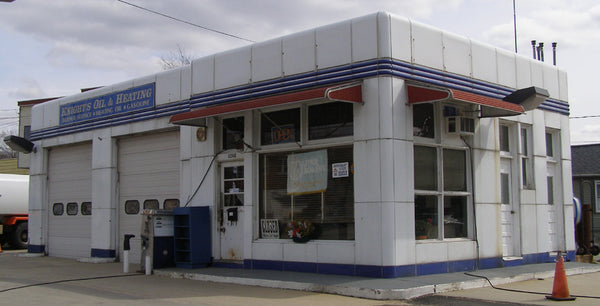Lustron, The All Steel House
Posted on 04 September 2015
The years after World War Two were a hectic time for the housing market in the United States. Virtually no housing had been built in nearly twenty years as the country transitioned from the austerity of the Great Depression straight into the rationing of World War Two. When American soldiers started coming home after the war they needed a place to start new lives with new families.

Many companies looked for ways to capitalize on the technologies developed for the war effort as well as utilize the surplus of industry available to them to satiate the nation's new demand for housing, cars, and consumer goods. Tupperware was making plastic food containers in lieu of their chunky, unsealed glass predecessors. Spartan Aircraft made sleek, high tech camping trailers designed after and built of the same materials as their airplanes.

Carl Strandlund was one such entrepreneur who made an attempt at entering the new consumer market and taking advantage of the opportunity afforded by the housing shortage. Strandlund had developed prefabricated gas stations that could be assembled onsite out of steel panels coated with baked on vitreous enamel - the same stuff that your blue speckled camping mugs are made of - but war rationing on steel put the kibosh on any progress. Seeing the need for housing, Strandlund teamed up with Chicago architects Roy Burton Blass and Morris H. Beckman to reformat the enamel gas stations into ranch houses.

Strandlund took his idea for an all steel home to the Reconstruction Finance Corporation, a federal agency from the depression era that had taken to solving the post war housing shortage by selecting three housing manufacturers to subsidize. Strandlund was granted a 12.5 million dollar loan to start the Lustron Corporation, as well as a $428,000 annual lease on half of the dormant Curtis-Wright aircraft plant. Strandlund would come back to the RFC in the coming months to request more loans with the promise of making 100 houses a day with a price tag of $7,500 each.

Strandlund wasted no time in spending the government's money. Lustron homes went into production in 1948 with model homes being shown in major cities all over the midwest and East coast. The Newport, Meadowbrook, and Westchester were the first (and ultimately only) models manufactured. All three were to be made entirely of vitreous enamel steel panels inside and out, the only exception being the concrete slab they sat on. The entirety of a Lustron house can be wiped clean with a wet rag or simply hosed off inside and out. The Lustrons are fire proof, rodent proof, and never require paint. The steel shingles never need to be replaced as long as they are kept clean and in good repair. All houses were modestly styled on the exterior, differing from their wooden suburban brethren mostly in that they glinted in the sunlight. Their real visual eccentricity was on the inside.

All living spaces were generously adorned with built-ins, such as a steel vanity in the bedroom, steel bookshelves for the living room, and steel bathroom cabinetry and fixtures. The kitchen was a masterpiece of Machine Age efficiency, with its stainless steel trimmed cabinetry and hidden combination dish/clothes washer. The houses were equipped with radiant heaters which heated up the ceiling panels. Lustron suggested it was not dissimilar to having the sun overhead. The houses had a serial number tag riveted to the laundry room wall for quick identification.

A year into production Lustron had drummed up 234 licensed dealers for their homes on a franchise system. They homes were delivered via specially designed truck, flat packed with an assembly manual. There were about 3,000 parts depending on model. Not unlike a monster predecessor to Ikea furniture.

Unfortunately Strandlund overshot quite a bit with his 100 houses a day promise. It didn't take long for the RFC to lose confidence in Lustron. It needed to make at least 50 homes a day to break even, but was only making 26. The houses were more expensive than traditional wood houses. For those willing to pay for a Lustron there were long wait times to receive your home. It also didn't help that increasing pressure to foreclose on Lustron was being put on Congressmen by contractors and trade unions who felt threatened by potential competition.

Lustron had only been making houses for a bit over a year when it was shut down. The defunct company left a shattered Strandlund, 2,680 houses manufactured and sent all over the eastern US, a long list of unfulfilled orders, and 37.5 million dollars of debt to the federal government. Strandlund died in relative obscurity in the 70's, but it can be argued that of all the most lofty housing solutions proposed in the post war era, his was the most successful.

The domes of Wallace Neff were too weird and Buckmister Fuller's Dymaxion houses were all together too much. There are still over 1000 Lustrons standing, many still in very good condition with little to no maintenance having been performed to them over the years. Most that have been torn down were simply not appreciated as houses or were in the way of new development. After over 60 years the Lustron has proven itself as a valid and functional design. Thankfully they have started to gain a devoted following in the last few years. Lustrons have been designated as histroic buildings as well as displayed an the MOMA next to the work of the legendary designer and architect Jean Prouvé. Perhaps Strandlund's houses came too soon, or perhaps there really was no larger role for them in American society, but It can't be said that they aren't functional dwelling machines.